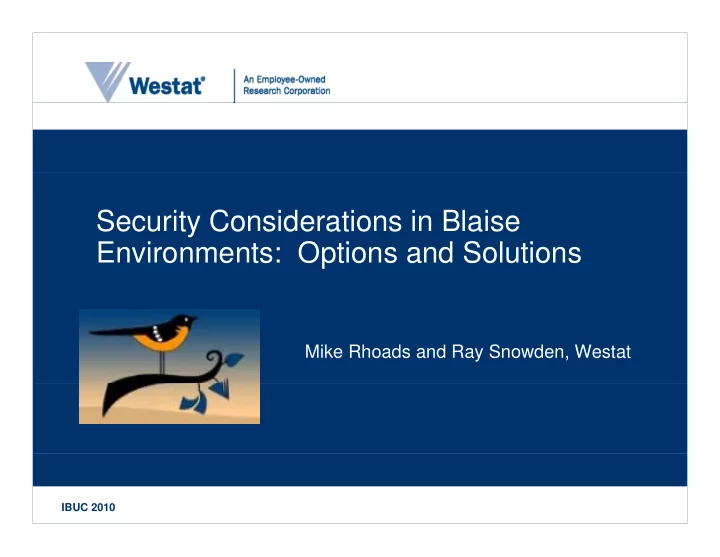

Security Considerations in Blaise E Environments: Options and Solutions i t O ti d S l ti Mike Rhoads and Ray Snowden, Westat IBUC 2010
Importance of IT Security p y • Sample headlines Sample headlines Virginia (8/27/2010) — Virginia's IT operations arm has repaired the cause of a statewide IT system failure that affected online services and network operations of more than 20 of its agencies, including the Department of Motor Vehicles (DMV). Washington (5/22/2006) — America's veterans were sent scrambling for their credit reports Monday, as the Veterans Administration announced nearly all of them — and some of their family members — were at heightened risk for y g identity theft. • Vulnerabilities and risks for survey data collection Platform-specific (laptops, Internet, etc.) PII and other highly sensitive information Professional and legal ramifications Professional and legal ramifications 2
Topics for This Talk p Quick high level overview of: Quick, high-level overview of: • Basic elements of an IT security framework • Aspects of Blaise relating to IT security • Platform-specific security considerations 3
4 Basic IT Security Framework y
Based on “FISMA” • Federal Information Security Management Act of 2002 Federal Information Security Management Act of 2002 Foundation for IT security of U.S. Government information systems • Concepts similar in ISO/IEC 27001 (leading private and p ( g p international standard) 5
Three Central Objectives of FISMA j • Confidentiality • Confidentiality • Integrity • Availability (just remember C-I-A) 6
Risk Management Framework g • Two dimensions of risk for possible threats: Two dimensions of risk for possible threats: Magnitude and prevalence of a threat Amount of harm resulting from the threat • Risk Management Framework (RMF) – approach to security planning developed by NIST Categorize system – low, moderate, high C t i t l d t hi h Select initial set of baseline security controls Implement the controls and document their deployment Assess the controls Authorize system operation (ATO) Monitor / assess controls on an ongoing basis Monitor / assess controls on an ongoing basis 7
Examples of Security Controls p y AT-2 AT-2 SECURITY AWARENESS SECURITY AWARENESS Control: The organization provides basic security awareness training to all information system users (including managers, senior executives, and contractors) as part of initial training for new users, when required and contractors) as part of initial training for new users when required by system changes, and [ Assignment: organization-defined frequency] thereafter. PE-5 ACCESS CONTROL FOR OUTPUT DEVICES Control: The organization controls physical access to information system output devices to prevent unauthorized individuals from system output devices to prevent unauthorized individuals from obtaining the output. 8
Security Control Categories y g • Security policies – establishes organizational commitment and Security policies establishes organizational commitment and approach • Human controls – security training, access agreements, screening • Physical controls – fire prevention, secure access, locked cabinets • Technical controls – encryption, anti-virus, complex passwords • Systems management – development standards, change management • Auditing and monitoring – record failed logins, web site monitors A diti d it i • Systems continuity – data backups, recovery platforms, alternate site 9
Aspects of Blaise Relating to Aspects of Blaise Relating to Security 10
Role of Blaise in Project Security Framework j y • Blaise application just one of multiple layers of Blaise application just one of multiple layers of security • Provides some built-in security features Provides some built in security features • Must integrate into overall security framework FDCC / USGCB FDCC / USGCB Version control packages Testing • Mature product – successful and secure operation on many data collection efforts over the years 11
Solving a Common Confidentiality Problem g y • CAPI interview with some particularly sensitive CAPI interview with some particularly sensitive items • Want to make this section self-administered Want to make this section self administered • Don’t want interviewer to be able to get back to the answers answers 12
Blaise Code to the Rescue! RULES Th ThankYou.KEEP kY KEEP RespondentIntro NEWPAGE IF ThankYou = EMPTY THEN Ticket SmallOffence MajorOffence ELSE Ticket.KEEP SmallOffence.KEEP MajorOffence.KEEP ENDIF ThankYou 13
Using Relational Databases for Data Storage g g • Blaise Datalink – uses Microsoft OLE DB to allow • Blaise Datalink – uses Microsoft OLE DB to allow Blaise to store data in non-native formats (e.g., Oracle, SQL Server) • Take advantage of organization’s established security practices y p Access control Special security zones 14
Platform-Specific Security C Considerations id ti 15
Web Surveys y • “Public” Internet is just that – need wide range of safeguards • Data storage format – advantages of using relational database thro gh Datalink database through Datalink • User authentication and authorization Nice write-up of technical aspects in Blaise documentation Ni it f t h i l t i Bl i d t ti Secure communication of credentials to respondents • Communications encryption – Secure Sockets Layer yp y (SSL) 16
CAPI Surveys y • Environment – portable devices, need to synchronize p , y data and software with home office • Encryption (on the laptop, during transmission, safeguarding keys) • User authentication (password policies, other access protections user training resets) protections, user training, resets) • Platform controls (disable unneeded services/devices, firewalls anti-virus etc ) firewalls, anti virus etc.) • Configuration management (need to implement, test, and log updates) g ) 17
18
Conclusion • Importance of an overall framework for IT security p y management (such as FISMA) Use broad set of security controls to reduce risks to confidentiality , integrity , and availability of applications and data applications and data • Different survey platforms share some common issues, but also present unique problems , p q p • You’re in good hands with Blaise! 19
20 Questions?
Recommend
More recommend